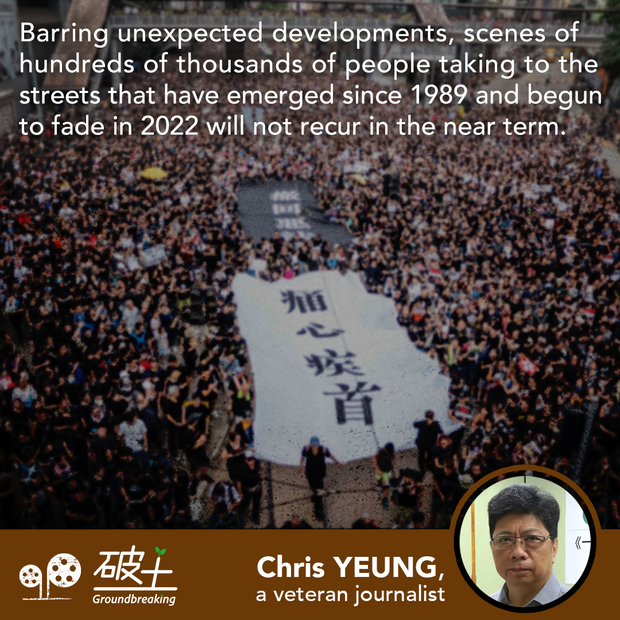Freedom of rallies with Police rules

First it was the Hong Kong elections with Chinese characteristics held in November 2021. On March 26, Hongkongers and the world saw what could be called a Hong Kong rally with Chinese characteristics.
Taken together, they have shed more light on the state of civic rights and freedoms in what cynics described as “New Hong Kong” under the name of “one country, two systems” political framework
Billed as the first public rally against government policy since the lifting of anti-Covid restrictions, the rally organised by a residents’ group in Tseung Kwan O against a land reclamation plan adjacent to their homes has turned out to be an eye-opener in many aspects.
The number of participants was capped at 100. They had to wear a number tag around their necks at all times. People were not allowed to join the march mid-way after it had begun. Organisers said they were required to send all banners and posters and posts on social media related to the march to the Police for their consent. “Political” content was said to be prohibited. Participants were advised not to wear in black or yellow, which had been described as the “colours” of the 2019 social movement.
Those conditions were unheard of in Hong Kong, once known for its unfettered freedoms that had been fully demonstrated in public rallies and assemblies on some “red-ink” dates, including June 4 (Tiananmen Square protest anniversary), July 1 (sovereignty changeover) and January 1 (New Year’s Day).
There was no cap on the number of participants. Be it held at the Victoria Park or along the main roads covering the busiest district in Hong Kong Island, people could join at any points along the route of the rally, take a cup of coffee at Starbucks and rejoin the procession any time. If a number tag had been a must, organisers might have to prepare a total of 2 million tags on June 16, 2019.
Those days are gone. It is now a case of freedom of holding rallies in Hong Kong with conditions imposed by the Police.
Defending the new rally rules, Chief Executive John Lee attributed it to what officials branded as “black violence” during the 2019 protest. “We have to be careful that any public gathering will not be either hijacked or turned into troubles that will cause not just inconvenience, but risk to public order, public safety and also national security.”
He added that the police chief has the duty to ensure that public gatherings proceed in an “orderly, safe and lawful manner.” The police commission, he said, “will, as a result of each public gathering, look at what has happened and then gather the experience… for future handling.”
Convenor of the Executive Council, Regina Ip, took a similar line, saying the authorities will review the March 26 rally.
Judging from the new set of conditions imposed on the rally, it is clear that the Police has attempted to use the march, the first being approved since the 2019 protest was brought to an end because of the Covid pandemic, as a case to test the limits of people’s tolerance to restrictions on freedoms.
Not surprisingly, there were some sharp words uttered by the protesters and organisers against some strict conditions, in particular the number tag. But opposition against the fundamental change of the rules of rallies has been modest. As expected, the Legislative Council was silent. Few lawmakers had taken the initiative of making a comment on the new rally rules.
The media was largely silent. As of Wednesday (three days after the Sunday rally), only one Chinese-language newspaper wrote an editorial on the new rally rules. Ming Pao said in its editorial the requirement of wearing a number tag created a bad image of Hong Kong. It warned of making Hong Kong a laughing stock in the world, calling on the Government to drop the requirement.
That has proved to be the lone voice in the traditional media. The eerie silence over what many had described as a humiliating tag-wearing requirement resonated in the media, political circles and society at large reflects a mixed feeling of futility and helplessness prevalent among the populace.
The official rhetoric of the existence of residual, hidden threats against national security has been a success in justifying the Police’s strict new rules in managing people’s right to hold rallies.
Seen from the communist authorities’ obsession with fears, both real and self-perceived, about threats to national security, it is unrealistic to expect the Hong Kong administration to deviate from the official line when it comes to national security.
Once the rules of rallies have been tightened, the possibility of major loosening in the near future looks slim.
Barring unexpected developments, scenes of hundreds of thousands of people taking to the streets that have emerged since 1989 and begun to fade in 2022 will not recur in the near term. Like the number tags on the neck of participants, Hong Kong with rallies being held under strict, and awkward, rules looks weird.
▌[At Large] About the Author
Chris Yeung is a veteran journalist, a founder and chief writer of the now-disbanded CitizenNews; he now runs a daily news commentary channel on Youtube. He had formerly worked with the South China Morning Post and the Hong Kong Economic Journal.